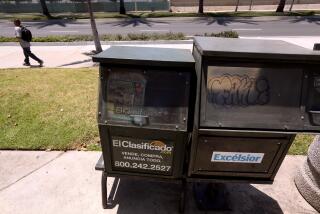Cable Reaches Out to Mom-and-Pop
- Share via
Hoping to grab an even bigger slice of the region’s surging small-business market, Southern California cable-television companies are rolling out new products and prices in a bid to lure ever smaller mom-and-pop advertisers.
Over the last year, at least four of the area’s largest cable players have broken apart formerly sprawling ad zones, a move that has made rates more affordable for local businesses, which can now squeeze their message into areas as compact as 10 square miles.
This less-is-more strategy is attracting the likes of J.R. Stanley, a San Clemente auto-repair shop owner who used to spend $1,000 a month on phone book advertising alone. Last month, he began channeling that same ad budget into 30-second cable spots in a slimmed-down region created by the local sales arm of Atlanta-based Cox Communications.
Ads touting Stanley’s performance-enhancing tuneups now run during breaks in Dodger and Angel games that are televised in a 15-mile crescent of communities from Laguna Hills to the San Diego County line. The streamlined zone allows Stanley to target his core clientele of 18- to 40-year-old men in roughly 90,000 households, all of them within an easy drive of his shop.
Since their debut, the spots have attracted at least 10 new customers looking to spend as much as $500 each to soup up their cars, trucks and SUVs, Stanley said.
“I think the TV thing is probably the best thing we’ve ever done,” he says, vowing to dump his phone book advertising for good.
Cable industry observers predict such “cell division” in advertising zones will only accelerate as cable companies increasingly turn to small businesses to help drive ad revenue. Last year, single-location retailers and mom-and-pop services accounted for roughly two-thirds of all cable-TV spots shown in greater Los Angeles. Those commercials generated $69 million in ad revenue, a 14% jump over the previous year, according to Adlink, which sells national advertising to cable systems in the five-county region.
Nationwide, local cable advertising has been rising steadily for the last 10 years, reaching $2.5 billion in ad sales in 1998. The figure accounted for nearly one-quarter of last year’s $10.4 billion total cable ad revenue.
“People who never used to buy cable are now buying cable,” said Vicki Lins, Adlink’s marketing director.
Cox is banking that more small-business owners will make the switch to what it is now touting as “Neighborhood TV.” Slicing its former 155,000-subscriber South Zone into two smaller regions forced the company to make a $350,000 investment in new transmission equipment. Not to mention the additional ad staff needed to concentrate on small fry such as Stanley.
But Linda Kohlhagen, general manager for Irvine-based CableRep Advertising, Cox’s ad sales subsidiary, predicts the additional costs will pay off with higher ad revenue. Before the zone breakup, Kohlhagen said, “we were pricing ourselves out of the market for some of the smaller businesses.”
Tom Gombas, ad sales manager for Century Communications, said similar thinking went into his company’s decision late last year to break up its far-flung Los Angeles Zone into three smaller parts. “What we’re trying to do is better accommodate smaller businesses,” he said. The move brought Century’s total ad zone count up to 14.
St. Louis-based Charter Communications, which keeps local offices in Alhambra, has also gotten into the act. Over the last year it has subdivided its territory into 12 ad zones, up from eight at the beginning of 1998.
Although overall cable ad rates have been rising over the last few years, smaller zones allow advertisers to pay less to reach fewer customers closer to home. Industry observers say those economics, coupled with a growing recognition of cable’s power and precision, have touched off a surge of interest among small businesses looking to flash their messages across the TV screens of would-be customers.
“Ad sales are just jumping out of the water. We almost can’t keep up with demand,” said Gisselle Acevedo-Franco, spokeswoman for MediaOne, which last year saw ad revenue surge 52%. The Denver-based company operates a regional ad sales headquarters in Bellflower.
Unlike broadcast television, cable systems have the ability to place ads on dozens of different networks that attract distinct groups of viewers. Teens flock to MTV. Baby boomers tune into VH1. Women converge on Lifetime and men gather around Fox Sports, one of the channels targeted by Stanley’s auto-repair shop.
What’s more, cable TV allows advertisers to home in on specific geographic sectors while completely bypassing others. Few other ad vehicles, with the exception of direct mail and zoned editions of major newspapers and magazines, offer that kind of flexibility. MediaOne, for example, has chopped its vast coverage area with 600,000 subscribers into 18 smaller ad zones. The company recently split one large zone that had encompassed Western and Central Los Angeles after businesses complained they were wasting money advertising outside their immediate area.
Indeed, smaller is better for many local businesses that either can’t afford or don’t need the wide audiences delivered by broadcast media.
Ken Kaiden, manager of Beverly Hills Ford, said his company turned to Century Communications only after the cable company, which serves 450,000 households from Ventura to Anaheim, separated its West L.A. ad zone from a bigger region that stretched east to Silver Lake and north into the Valley. Kaiden got the target market he wanted and lower rates to boot.
He pays as little as $875 a week for his ad to appear on such channels as ESPN, CNN and MSNBC. He says he used to pay more than twice that amount per week to advertise on a single radio station.
“I just want to be in our immediate market area,” said Kaiden, who hopes his new cable ad, which debuted on Memorial Day, will boost sales 15% from the current pace of about 100 vehicles a month.
In contrast, ads on radio and broadcast television are locked into the full sweep of the signals that carry them, often covering hundreds of square miles. Such reach comes at a cost. Ads on radio and broadcast TV, even excluding exorbitant prime-time slots, can average between $500 to $700 per spot, says Bill Jaros, president of Woodland Hills-based Progressive Marketing Group. Those same rates, Jaros said, could pay for a typical 10-day cable campaign, with the spots appearing up to four times daily.
Established media are feeling the heat. Over the last two years, local cable has swiped 14% of all TV viewers in Southern California from broadcast television, giving it a nearly 40% share, Adlink reports. At the same time, cable subscriptions have jumped by 222,000 households, totaling more than 3.3 million homes and accounting for nearly two-thirds of all TV watchers in the region.
Advertising industry observers predict cable will continue to challenge print and broadcast players, particularly after its anticipated marriage with the Internet and widespread introduction of broadband transmission technology.
“The eyeballs have left the traditional broadcast signals and are now all over the dial,” said Bill Rosendahl, senior vice president at Century.
But just what are these eyeballs seeing when it comes to local ads on cable?
Shaky camera work, scratchy sound and low-tech graphics are trademarks of many local ads, some made for as little as $600. Business owners frequently write and star in their own commercials, fighting self-conscious grins as they stammer through their cue cards.
But some say that’s exactly why these ads can work. Consumers are just as likely to remember a spot that makes them cringe as they are one that wows them with the latest digital wizardry. Anyone who has seen Boxspring Bob’s disembodied head yakking a mile a minute from its mattress perch isn’t likely to soon forget it.
Recognition was the goal for Burbank restaurateur Jim Lucero, who penned his own scripts for his Smoke House eatery ads, which have aired on Century for the last two years. One 30-second spot tells the story of Lucero’s “ideal restaurant,” a place with a friendly staff, inviting atmosphere and “the world’s best garlic bread.” The commercial ends with a beaming Lucero boasting that, most of all, his ideal restaurant is “a place I can bring my kids.” The spot cuts to a shot of Lucero’s own apron-clad sons schlepping dirty dishes into the kitchen.
Lucero admits the spot is “corny,” but he says slick, professional ad “would lose the essence of what I’m trying to say.”
“What I want is for people to recognize me and my sons wherever we go,” he said.
Lucero apparently has gotten his wish. A while back, the restaurateur was riding an elevator in Montreal when a fellow passenger turned to him and said, “Hey, you’re the guy with the world’s best garlic bread.”
Ad mission accomplished.
(BEGIN TEXT OF INFOBOX / INFOGRAPHIC)
Tuning In to Cable
During the last few years, the region’s cable systems have lured 14% of all TV viewers in Southern California away from broadcast television. By the end of February, cable had captured a total market share of 39%. Cable’s expanding audience is just one factor behind the medium’s growing advertising cachet. Cable’s viewership share, measured in February, May and November:
February: 39% share of all TV watchers in Southern California
More to Read
The biggest entertainment stories
Get our big stories about Hollywood, film, television, music, arts, culture and more right in your inbox as soon as they publish.
You may occasionally receive promotional content from the Los Angeles Times.










